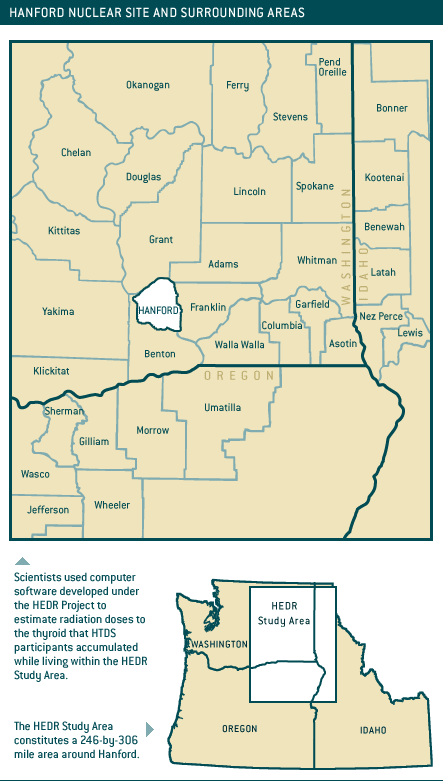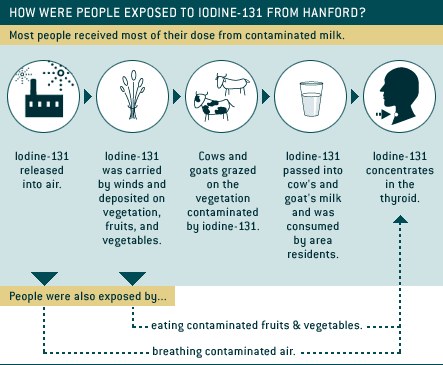HTDS Guide - Hanford History
Return to The Hanford Thyroid Disease Study page
Section Summary
From 1944 through 1957, large amounts of radioactive materials were released into the atmosphere at Hanford.
- Milk consumption was the major way most people were exposed to Hanford’s iodine-131.
- Public concern led to the release of previously classified information about Hanford’s operations.
- No other studies are directly comparable to the Hanford situation.
The Hanford Nuclear Site occupies about 560 square miles in southeastern Washington State, adjacent to the towns of Pasco, Kennewick and Richland. The facility was the world’s first large-scale nuclear production plant. It was constructed in the early 1940s as part of the Manhattan Project to produce plutonium for nuclear weapons.
Over the course of many years, large amounts of radioactive materials (radionuclides) were released into the atmosphere and the Columbia River as part of the plutonium production process.
The major radioactive releases occurred in the form of gases and particles into the air from 1944 through 1957. These releases occurred mainly because of increased production and lack of filter systems. Changes in the production process over the years greatly reduced releases into the air.
Many different kinds of radioactive materials were released. For many people living in the region, most of their dose was due to iodine-131 released into the air.

Iodine-131 was carried by winds to surrounding areas and deposited on vegetation. It was then absorbed in the milk of cows and goats that grazed on the contaminated vegetation. Drinking contaminated milk caused most of the radiation dose for most of the exposed people.
People were also exposed by eating contaminated fruits and vegetables, and by breathing contaminated air.

For a long time, details about Hanford’s operations were not public. In 1986, as a result of public concerns and requests made through the Freedom of Information Act, the U.S. Department of Energy (DOE) began releasing tens of thousands of pages of previously classified or unavailable documents.
The documents revealed to the public, for the first time, that substantial quantities of radionuclides were released into the environment from Hanford.
CDC convened a panel of independent scientists (Hanford Health Effects Review Panel) to evaluate the DOE documents. Two of the panel’s most important recommendations were to conduct a study to estimate the radioactive materials released from Hanford and to determine the feasibility of studying the health effects to the thyroid of that exposure.
The panel’s recommendations evolved into what are known today as the Hanford Environmental Dose Reconstruction Project (HEDR) and the Hanford Thyroid Disease Study (HTDS).
The main reason why the HTDS was conducted is that the public, health officials and scientists were concerned about the possible health effects of Hanford’s radiation.
Thyroid disease was a particular concern because iodine concentrates in the thyroid gland and the DOE documents showed that large amounts of iodine-131 were released from Hanford. In response to public concerns, Congress directed CDC to conduct a study of the effects of Hanford’s iodine-131 on thyroid disease.
Many people ask, “Didn’t we already know that Hanford radiation causes thyroid disease?” Over the years, many studies of other populations have provided compelling reasons to suspect that the risk of thyroid disease might have increased in people who were exposed to Hanford’s iodine-131.
Nevertheless, the published literature left room for doubt, since none of the studies examined circumstances quite like those of the Hanford experience. The following are ways other radiation studies are different from the Hanford situation:
Type of radiation exposure – External irradiation by gamma rays (such as the atomic bombings in World War II) or x-rays used in medical treatments may have different effects than iodine-131.
The people who were exposed – People who received iodine-131 for treatment or diagnosis already had, or were likely to have, thyroid diseases, while people exposed to Hanford’s iodine-131 were a general population, including some people with good health and some with poor health.
How big the doses were – Doses of iodine-131 used for medical treatments are much higher than anyone is likely to have received from Hanford’s iodine-131. Doses from Chernobyl’s fallout were higher as well.
How long people were exposed – External irradiation typically occurs within a few seconds or minutes. Medical exposures of iodine-131 typically occur over days to weeks. Exposure to Chernobyl’s fallout occurred from weeks to months. In contrast, many of those exposed to Hanford’s iodine-131 were exposed over a period of several years.
Because other studies have addressed situations different from Hanford in important ways, it was necessary to study people who were actually exposed to Hanford’s iodine-131 in order to get the most reliable answer to the question of whether thyroid disease had been increased by Hanford’s iodine-131.
No study can determine the cause of an individual case of thyroid disease. However, an epidemiological study, such as the HTDS, provides the best way to determine whether disease has increased in a population exposed to a potentially harmful agent such as radiation.
Hanford-related Studies
Hanford Environmental Dose Reconstruction Project (HEDR)
Purpose
- Estimate type and amount of radioactive materials released from Hanford.
- Model how radioactive materials moved through the environment and food chain.
- Develop computer software for estimating individual doses.
- Estimate radiation doses to representative individuals in the Hanford region.
Conduct of the Study
- Began in 1987; final report issued in 1994.
- The study was directed by an independent technical steering panel selected by deans of research universities in Washington and Oregon.
- The study was conducted by Battelle Pacific Northwest Laboratories originally under contract with the U.S. Department of Energy (DOE). Management responsibility was transferred to CDC in 1993.
Hanford Thyroid Disease Study (HTDS)
Purpose
- Study the risk of thyroid disease among persons exposed to radioactive iodine-131 from Hanford.
Conduct of the Study
- Began in 1989; final report issued in 2002.
- Scientific and technical work were performed by the Fred Hutchinson Cancer Research Center under contract with CDC.
- The research team used HEDR computer software together with information provided by HTDS participants to estimate individual radiation doses to the thyroid.